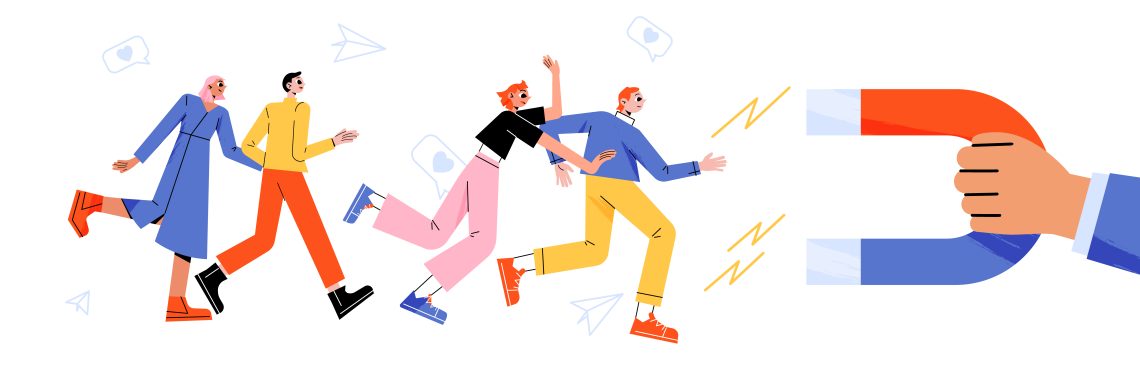You’ve been trying to grow your business by increasing your revenue, and you’ve decided that what you need is more customers.
Good idea!
You go on a search for the best ways to acquire new customers. You offer referral discounts for your current customers, pay for IG, Facebook, and Google Ads, and maybe even use affiliate marketing or pay several micro-influencers to drive some new customers your way.
And it works!
The conversion rate on your spending is pretty impressive. You have more customers now. However, after 1st purchase, you lose about 40% of these new customers, 2nd purchase, an extra 15% or thereabout, and a couple of months later, you’re back to square one!
Your customer base isn’t the size you need it to be. You look at all the money you invested in influencers and ads, and you’re genuinely pissed at how much money and effort you’ve wasted.
Then you ask yourself, What did I do wrong?
After Acquisition, Retention.
While acquiring new customers is important, retaining them and making sure they become frequent customers is just as important. Focusing on customer acquisition but neglecting customer retention jeopardizes all efforts you put into acquiring the customers in the first place.
There are various reasons why you should prioritize customer retention. First, retaining customers is way cheaper than getting new ones; the cost of acquiring one new customer is 5X the cost of retaining an already acquired customer. Second, repeat customers are more profitable. A study revealed that a 5% increase in customer retention can increase profits by 25% to 95%. Repeat customers are more likely to increase the amount they spend per purchase, try out new products, spend more, and are less price-conscious. Third, they provide valuable feedback that helps improve the quality of products and services. Lastly, they offer free word-of-mouth advertising and referrals, which help with acquiring new customers at no cost.
Customer Acquisition is important in expanding your customer base. However, don’t ever risk losing the customers you’ve acquired because you think getting them through the door is enough to guarantee that they’ll stay for a long time. After the acquisition, develop a solid retention plan to make all the hard work worth it.
So, how can you retain customers? Here are a few ideas.
- Have a customer loyalty program where you reward your most committed and profitable customers.
- Post-Sales interaction. Build a relationship with your customers through regular communication and interaction. Don’t make all communication business-related or a call-to-action for sales. Genuinely communicate and build rapport with customers. If possible, consider adopting a communication calendar to manage customer engagement and keep track of the last time customers have reached out or interacted with the brand.
- Personalization. This involves personalizing future communication, retention efforts, and cross-selling/up-selling efforts per customer. Tailor your engagement efforts to the needs and particular circumstances of your customers rather than implementing a general strategy across the board. You’re collecting lots of data on your customer. You should use this data to personalize their experience. You should know how customers like to be contacted, what they bought previously, and what the previous interactions look like. Sending generic information that does not apply to the customer breeds frustration. By offering a personalized experience, they will associate your company with a smooth and easy experience. Research from Econsultancy found that personalization based on purchase history, user preferences, and other relevant information delivers a high-impact Return On Investment (ROI).
- Improve customer experience by leveraging technology. Instead of frequently sending survey forms to customers, leverage technology to analyze the wealth of customer data you have. Some businesses have access to data like customer interactions on their digital platforms, e.g., websites, online stores, data on purchase behavior, location, social media activity, etc. Why use surveys to ask customers about their experiences when data about customer interactions can be used to predict both satisfaction and the likelihood that a customer will increase business, remain loyal, or increase the business?
- Deliver Omnichannel Customer Service. Customers expect engagement and seamless transitions between channels like phone, social channels, and websites. When you understand how customers interact with your brand across multiple channels, you can optimize your processes to reduce customer frustration. This improves customer satisfaction and helps retention. Make sure that you identify the most preferred channel of communication by customers and be where they are 24/7 to deliver customer support. If customers are reaching out more on Twitter, don’t direct them to a website to get their issue solved; instead, migrate most of your customer support to Twitter to meet them where they are. When you are able to engage customers seamlessly by being where they are and providing consistent service across channels, you deliver the best omnichannel customer service.
- Increase your switching costs. This entails putting in various elements that make it expensive, stressful, or difficult for customers to switch to another brand. For example, IOS users find it difficult to switch to Android partly because of the difficulty or the risk of losing their data, phone history, and records stored on iCloud. If you decide to use high switching costs as a strategy, avoid a situation where customers are highly displeased with the product but continue using it because it is more expensive to switch. In such a case, if a new competitor covers this high switching cost, you stand a chance of losing a lot of your customers.




